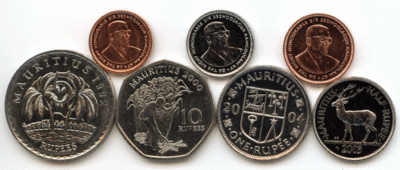毛里求斯卢比
出自 MBA智库百科(https://wiki.mbalib.com/)
毛里求斯卢比(Mauritius Rupee 原符号:Maur. Rp. 标准符号:MUR)
目录 |
The rupee is the current currency of Mauritius. It is divided into 100 cents. The ISO 4217 code of the currency is MUR. 1MUR=100 centimes
History
The rupee was established by law in 1876 as the local currency of Mauritius. The rupee was chosen due to the massive inflow of Indian rupees following Indian immigration to Mauritius. The Mauritian rupee was introduced in 1877 to replace the different currencies in circulation: the Indian rupee, the pound sterling and the Mauritian dollar. The Mauritian rupee was equal to one Indian rupee or half a Mauritian dollar. The pound sterling was worth 10 1/4 rupees at that time. The Mauritian currency also circulated in the Seychelles until 1914, when it was replaced by the Seychellois rupee at par.
In 1934, a peg to sterling replaced the peg to the Indian rupee, at the rate of 1 rupee = 1 shilling 6 pence (the rate at which the Indian rupee was also pegged. This rate, equivalent to 13 1/3 rupees = 1 pound sterling, was maintained until 1979.
Coins
In 1877, coins for 1, 2, 5, 10 and 20 cents were introduced, with the lower three denominations in copper and the higher two in silver. Coin production ceased in 1899 and did not recommence until 1911, with silver coins not produced again until 1934, when 1/4, 1/2 and 1 rupee coins were introduced. In 1947, a cupronickel 10 cent coin was introduced. Coins made of cupronickel replaced the other silver coins in 1950.
Mauritius did not gain independance from the UK and become a republic until 1992. In 1987, a new series of coins was introduced which, for the first time, did not feature the portrait of the queen of England, but rather that of Sir Seewoosagur Ramgoolam. This new coinage consisted of copper plated steel 1 and 5 cents (the 5 cents was substantially reduced in size), nickel-plated-steel 20 cents and 1/2 rupee, and cupronickel 1 and 5 rupees. The ten rupee banknote was replaced by a cupronickel 10 rupee coin in 1997. Currently the only denominations of coins remaining in circulation on Mauritius are the 1, 5 and 10 rupee coins.
Banknotes
The first Mauritian banknotes were issued by the Government of Mauritius in 1876 and came in denominations of 5, 10 and 50 rupees. A 1 rupee notes was added to the series in 1919. In 1940, due to the metal shortage caused by the war, emergency issues were introduced in the denominations of 25 and 50 cents and 1 rupee. In 1954 the Government of Mauritius introduced a new series of banknotes depicting the new queen; Queen Elizabeth II. The 1954 series of banknotes was issued in denominations of 5, 10, 25 and 1000 rupees. The 1954 banknotes of 1000 rupees are extremely rare and highly collectable.
In 1966 the responsibility for the issuance of banknotes and coins was passed from the government to the Bank of Mauritius. The Bank of Mauritius issued its first banknote series in 1967, comprising 4 denominations: 5, 10, 25 and 50 rupees. This set of banknotes went through four issues, with the only variations being the signatures of the Governors and the Managing Directors of the Bank of Mauritius appointed during the period of the issue.
The Bank of Mauritius introduced its fifth issue 1985, a completely new designed set of banknotes, in denominations of 5, 10, 20, 50, 100, 200, 500 and 1000 rupees. A close study of these banknotes reveals an interesting array of subsets which were printed by two different banknote printing companies. The notes were also designed at different time periods as there are very few identical and consistent design features appearing on all the denominations. Varying banknote numbering systems, different types of security threads, variations in the design and size of the Mauritian Coat of Arms, different ultraviolet light latent printing, inconsistent variations in the size increments between the denominations and multiple different typesets are just a few of the differences. This issue lasted up to 1998.
In 1998, The Bank of Mauritius made a sixth issue of banknotes consisting of 7 denominations, viz. 25, 50, 100, 200, 500, 1,000 and 2,000 rupees. These banknotes had a standard format and were all issued simultaneously in November 1998. All the banknotes of this issue were printed in England by “Thomas de la Rue Limited”. These banknotes were withdrawn from circulation in June 1999 following controversies. The Bank of Mauritius made its seventh issue of banknotes, which is still current today.
Related Currencies
Indian Rupee: Prior to the creation of the Mauritius rupee, Mauritius used the banknotes and coins of India
























